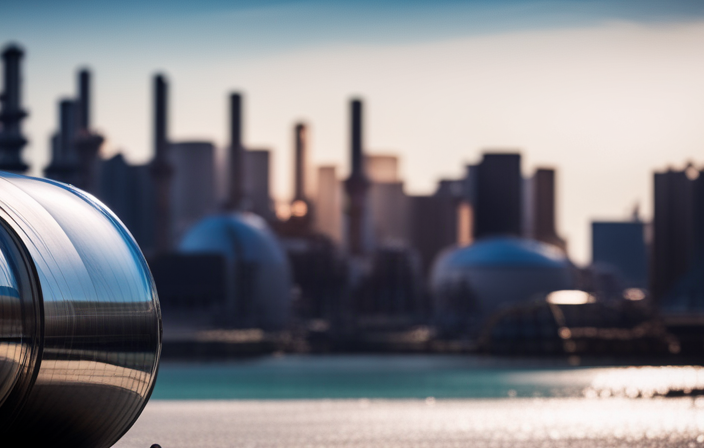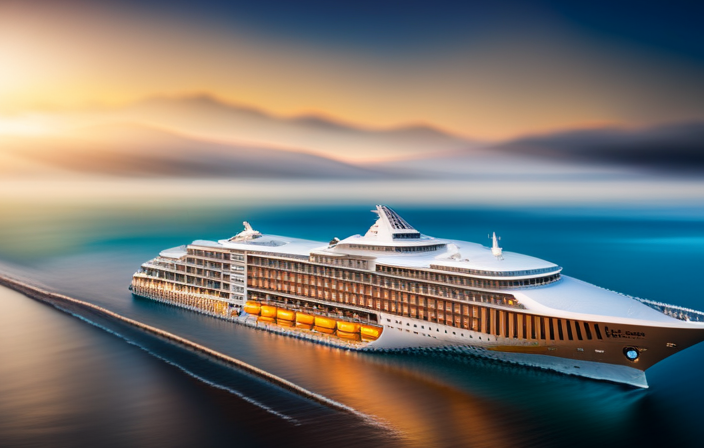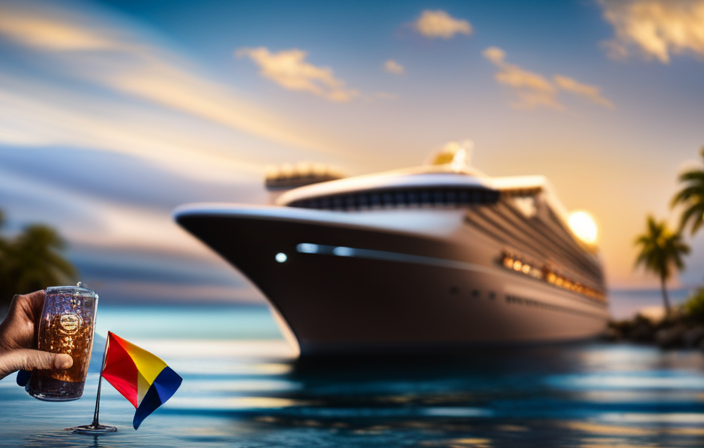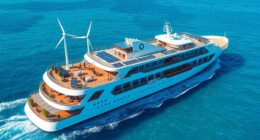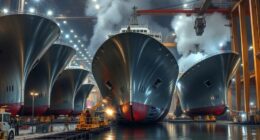Hello! Ever wonder how modern cruise ships stack up in size against the legendary Titanic? Prepare to be astonished as we explore the vast world of today’s maritime behemoths. In this piece, we’ll examine the evolution of cruise ship sizes, beginning with the era of the Titanic and progressing to the colossal vessels that traverse our oceans now.
Now, when I say big, I mean BIG. These modern cruisers make the Titanic look like a mere dinghy in comparison. As we delve into their dimensions, facilities, and amenities, we’ll uncover the sheer scale of luxury and entertainment that awaits passengers on these colossal vessels.
But let’s not forget the Titanic, the tragic ship that captured the world’s imagination. We’ll take a glimpse into the Titanic experience and discuss how its size impacted the cruise industry as a whole.
So strap on your life jackets, my friends, as we embark on a fascinating journey exploring the ever-growing world of cruise ships and their mind-boggling sizes.
Key Takeaways
- Modern cruise ships are significantly larger than the Titanic in terms of length, width, and height, with the largest cruise ships today being over three times the length of the Titanic.
- Cruise ships today have a much larger passenger and crew capacity, with the ability to accommodate thousands of individuals, including families, couples, and solo travelers.
- Modern cruise ships offer a wide range of facilities and amenities, including high-speed Wi-Fi, state-of-the-art entertainment, culinary excellence, and luxurious accommodations.
- The size of cruise ships has had a significant impact on the cruise industry, attracting more passengers, driving economic growth, and increasing competition among cruise lines to build larger and more innovative ships.
The Size of the Titanic
So, you’re probably wondering just how big the Titanic really was, huh? Well, let me tell you, the Titanic was an absolute behemoth of a ship.
In terms of construction, it stretched a whopping 882 feet and 9 inches in length, making it one of the largest ships ever built at the time.
Its interior design was no less impressive, boasting luxurious amenities like a grand staircase, lavish dining rooms, and opulent cabins.
The sheer size and opulence of the Titanic were a testament to the technological advancements of the early 20th century.
Now, let’s dive into the evolution of cruise ship size and see how it compares to the grandeur of the Titanic.
Evolution of Cruise Ship Size
Imagine stepping on board a modern ocean vessel, where the scale of its grandeur would dwarf even the most majestic seafaring marvels from a bygone era. The evolution of cruise ship size has been driven by constant innovations, resulting in a significant impact on the maritime industry.
Increased passenger capacity: Modern cruise ships can accommodate thousands of passengers, far surpassing the Titanic’s capacity of around 2,400.
Expanded amenities: These floating resorts offer a wide range of amenities, including multiple swimming pools, theaters, casinos, and even indoor skydiving simulators.
Enhanced safety features: Advanced technologies, such as stabilizers and state-of-the-art navigation systems, ensure a smooth and secure voyage for passengers.
These developments have revolutionized the cruise industry, attracting a larger customer base and creating new opportunities for economic growth.
Now, let’s delve into the dimensions of these modern cruise ships.
Modern Cruise Ship Dimensions
The modern cruise ships of today are the largest ever built, surpassing the size of the Titanic. These colossal vessels can measure up to 1,200 feet in length. They have a width of around 200 feet and a height of up to 240 feet. With such massive dimensions, these ships have the capacity to accommodate thousands of passengers and crew members. The range is typically from 4,000 to 6,000 individuals.
Largest cruise ships today
Get ready to be amazed at how massive the largest cruise ships today are compared to the Titanic! These modern marvels of engineering showcase the latest advancements in cruise ship technology, with a strong focus on sustainability efforts in the cruise industry.
Here are some mind-boggling numbers to give you an idea of just how big these ships are:
-
Length: The largest cruise ships today can measure over 1,100 feet long, which is more than three times the length of the Titanic.
-
Width: With a width of around 130 feet, these ships are almost twice as wide as the Titanic.
-
Height: These giants of the sea tower at over 200 feet, surpassing the height of the Titanic by almost 50 feet.
With these impressive dimensions, it’s no wonder that the size difference between the largest cruise ships today and the Titanic is truly awe-inspiring.
Now, let’s dive deeper into the length, width, and height comparisons in the next section.
Length, width, and height comparisons
Let your senses soar as we explore the staggering size similarities and dissimilarities between the largest cruise ships today and the majestic Titanic.
When it comes to length, the Titanic measured around 882 feet, while the largest cruise ship today, Symphony of the Seas, stretches a mind-boggling 1,188 feet.
In terms of width, the Titanic spanned 92 feet, whereas Symphony of the Seas reaches an impressive 215 feet.
As for height, the Titanic stood at approximately 175 feet, while the newest cruise ships can reach heights of up to 236 feet.
These stark differences in size can be attributed to the evolution of shipbuilding techniques and the impact of technology on ship size.
With these vast dimensions, it’s no wonder that the subsequent section about passenger and crew capacity will be equally as fascinating.
Passenger and crew capacity
Prepare to be amazed by the sheer number of people that can be accommodated on these modern giants of the sea. Cruise ships today are designed to hold an astounding number of passengers and crew members. The passenger demographics on these ships vary greatly, with families, couples, and solo travelers all seeking the excitement and luxury of a cruise vacation. To ensure the safety and well-being of everyone on board, crew members undergo extensive training in various areas, including emergency response, hospitality, and customer service.
To give you an idea of the passenger and crew capacity of these massive vessels, take a look at the table below:
| Cruise Ship | Passenger Capacity | Crew Capacity |
|---|---|---|
| Oasis of the Seas | 5,400 | 2,394 |
| Symphony of the Seas | 6,680 | 2,200 |
| Harmony of the Seas | 6,687 | 2,394 |
| Allure of the Seas | 5,484 | 2,384 |
As you can see, these cruise ships can accommodate thousands of passengers and employ a significant number of crew members to ensure a smooth sailing experience. Now, let’s explore the impressive facilities and amenities on these floating cities.
Facilities and Amenities on Cruise Ships
Imagine yourself stepping onto a modern cruise ship, where you’ll be amazed by the incredible facilities and amenities it offers compared to the Titanic. The future of cruise ship technology has revolutionized the onboard experience.
- High-speed Wi-Fi: Stay connected with loved ones and share your incredible journey on social media platforms, enhancing the cruise ship experience.
- State-of-the-art entertainment: Enjoy immersive theaters with 3D screens and virtual reality experiences, making each show a memorable event.
- Culinary excellence: Savor exquisite fine dining options curated by renowned chefs, offering a wide range of international cuisines.
- Luxurious accommodations: Indulge in spacious cabins with private balconies, plush bedding, and personalized service, ensuring ultimate comfort throughout your voyage.
These advancements in facilities and amenities redefine the cruise ship experience, creating a haven of luxury and entertainment.
Transitioning to the subsequent section about the Titanic experience, one can only imagine the stark contrast in offerings between the two eras.
The Titanic Experience
As you step back in time to the era of the Titanic, you’ll feel as if you’ve entered a time capsule, with its grandeur akin to a majestic floating palace. The Titanic, known for its tragic end, has left an indelible mark on history. Today, visitors can experience the Titanic’s grandeur at the Titanic Memorial, a tribute to the lives lost in the sinking of the Titanic. The memorial provides a glimpse into the luxurious interiors of the ship, showcasing its opulent design and intricate details. Walking through the memorial, you’ll be transported to a different era, where elegance and sophistication reigned supreme. The exhibition also offers a comprehensive look at the events leading up to the sinking, allowing visitors to gain a deeper understanding of this historical tragedy. Transitioning into the subsequent section about the engineering and design of modern cruise ships, we can explore how technology and innovation have revolutionized the industry.
Engineering and Design of Modern Cruise Ships
After experiencing the awe-inspiring Titanic, I’m fascinated by the engineering and design of modern cruise ships. Over the years, cruise ship design has undergone evolutionary changes and benefited from technological advancements.
These advancements have allowed cruise ships to become larger, more luxurious, and more efficient.
- Advanced propulsion systems enable greater speed and maneuverability.
- Improved stability systems ensure a smoother sailing experience.
- Innovations in architecture allow for larger and more spacious public areas.
- State-of-the-art safety features ensure passenger well-being.
The combination of these advancements has transformed the cruise industry, providing passengers with an unforgettable experience on board.
The impact of size on the cruise industry is significant, as larger ships can accommodate more amenities and provide a wider range of entertainment options.
In the next section, we’ll explore how these larger ship sizes have influenced the cruise industry and the overall cruise experience.
The Impact of Size on the Cruise Industry
Increased competition among cruise lines has been a direct result of the continuous increase in the size of cruise ships. As cruise ships become larger and more luxurious, companies are striving to outdo each other with newer, more innovative designs and amenities. This fierce competition has led to a surge in the number of cruise options available to consumers, ultimately benefiting the industry as a whole.
However, the economic implications of this size race are not to be ignored, as the cost of building and maintaining these massive vessels is substantial. Additionally, the environmental concerns associated with the increased size of cruise ships, such as carbon emissions and the impact on local ecosystems, cannot be overlooked and require careful consideration by both the industry and regulatory bodies.
Increased competition among cruise lines
The fierce competition among cruise lines these days is amazing. They go above and beyond to outdo each other. Increased competition in the cruise industry has led to various market trends that are changing the industry’s landscape.
Cruise lines constantly strive to offer unique and innovative experiences to attract more passengers. They invest heavily in new technologies, onboard amenities, and entertainment options to differentiate themselves from competitors. For example, some cruise lines have introduced virtual reality experiences, robotic bartenders, and even theme park-like attractions on their ships.
This intense competition has not only raised the bar for passenger expectations but has also led to a significant increase in the quality and diversity of cruise offerings.
As we delve into the economic implications of this competition, it becomes evident that the industry is not just about providing luxurious vacations. It also plays a vital role in driving economic growth and job creation.
Economic implications
With increased competition among cruise lines, the economic implications have become a crucial aspect to consider. The race to build bigger and more luxurious ships has led to significant investments and expenditures. Cruise lines are constantly trying to outdo each other, attracting passengers with state-of-the-art amenities and entertainment options.
This increased competition has not only resulted in higher ticket prices but has also created a need for constant innovation and improvement. As cruise ships continue to grow in size, the economic impact extends beyond the initial investment. These mammoth vessels require substantial maintenance and operation costs, leading to significant expenditures for the cruise lines.
Additionally, the economic impact of cruise ships extends to the local economies of the destinations they visit, as they bring in tourism revenue. However, with this growth, there are also concerns about the environmental impact, which will be discussed in the subsequent section.
Environmental concerns
Amidst the competition for grandeur and opulence, the cruise industry has set sail on a turbulent sea of environmental concerns.
As the demand for cruise vacations continues to rise, so does the need for environmental sustainability. Cruise ships are notorious for their large carbon footprints, emitting significant amounts of greenhouse gases into the atmosphere.
To address this issue, cruise lines are implementing various measures to reduce their environmental impact. These include the use of advanced propulsion systems, such as LNG-powered engines, which emit lower levels of pollutants compared to traditional diesel engines. Additionally, onboard waste management systems and water treatment plants are installed to minimize pollution in the oceans. Efforts are also being made to incorporate renewable energy sources, such as solar panels and wind turbines, to power certain onboard facilities.
Despite these initiatives, the cruise industry still faces challenges in achieving complete environmental sustainability. Transitioning to cleaner technologies and reducing carbon footprints remain ongoing priorities.
Now, let’s delve into the notable features on modern cruise ships.
Notable Features on Modern Cruise Ships
Imagine stepping onto a modern cruise ship and being awestruck by its impressive and innovative features.
These floating marvels are equipped with state-of-the-art facilities and cutting-edge technology that offer passengers an unforgettable experience.
From luxurious staterooms with panoramic views to extravagant dining options that cater to every palate, modern cruise ships have raised the bar in terms of comfort and convenience.
But it’s not just about indulgence; these ships also prioritize sustainable practices. They incorporate energy-efficient systems, waste management solutions, and even utilize renewable energy sources to minimize their environmental impact.
As we delve into the comparison of cruise ship vs. Titanic passengers, it becomes evident that modern cruise ships have revolutionized the way we travel at sea.
Comparison of Cruise Ship vs. Titanic Passengers
When comparing cruise ship passengers to those on the Titanic, it is important to consider travel demographics and preferences.
Modern cruise ships cater to a diverse range of travelers, offering various itineraries and onboard amenities to suit different interests and preferences.
Additionally, the onboard experiences on cruise ships differ significantly from those on the Titanic, with modern ships featuring state-of-the-art entertainment options, multiple dining venues, and a wide range of recreational activities.
Lastly, accessibility and inclusivity have improved significantly on modern cruise ships, with features such as wheelchair-accessible cabins, ramps, and elevators, ensuring that all passengers can enjoy their vacation comfortably and without limitations.
Travel demographics and preferences
If you’re a traveler, you might be interested in understanding travel demographics and preferences.
When it comes to travel preferences, individuals have various factors that influence their choices. Some travelers prioritize relaxation and luxury while others seek adventure and exploration.
Cruise ships cater to a wide range of preferences by offering an array of amenities such as spas, fine dining restaurants, and entertainment options like theaters and casinos. Additionally, cruise ships provide various activities for different age groups, including kids’ clubs and adult-only areas.
On the other hand, the Titanic, despite its grandeur, focused more on elegance and opulence. It offered amenities like a swimming pool, a gymnasium, and a Turkish bath.
These differences in onboard experiences highlight the evolution of the cruise industry and its ability to cater to diverse traveler preferences.
Differences in onboard experiences
As we delve deeper into the world of cruise ships, let’s explore the differences in onboard experiences.
One of the key aspects that sets modern cruise ships apart from the Titanic is the wide array of onboard entertainment options. From Broadway-style shows to live music performances, there is something to suit every taste and preference.
Additionally, dining experiences on modern cruise ships have undergone a significant transformation. Gone are the days of formal dining halls; instead, passengers can indulge in a plethora of culinary delights from around the world, with a variety of dining venues and options to choose from.
As we transition into the next section, it’s important to note that these enhancements in onboard experiences have also extended to the realm of accessibility and inclusivity, ensuring that everyone can enjoy the wonders of cruising.
Accessibility and inclusivity
You’ll be thrilled to discover that today’s cruise ships prioritize accessibility and inclusivity, ensuring that everyone can fully enjoy their onboard experience. Travel accessibility is a key consideration for cruise ship designers, who strive to create an environment that is accessible to all passengers. From ramps and elevators to widened doorways and specially designed cabins, cruise ships offer a range of accommodations to meet the needs of individuals with mobility challenges. Additionally, cruise ships provide accessible amenities such as accessible bathrooms, dining areas, and entertainment venues. To give you an idea of the level of accessibility offered, take a look at the table below:
| Accommodation | Description |
|---|---|
| Wheelchair ramps | Wide ramps throughout the ship for easy navigation |
| Elevators | Spacious elevators with braille buttons for easy access |
| Accessible cabins | Specially designed cabins with wider doorways and accessible features |
| Accessible bathrooms | Bathrooms equipped with grab bars and roll-in showers |
This commitment to accessibility ensures that all passengers can enjoy a comfortable and inclusive cruise experience. In conclusion, the world of cruise ships continues to evolve, with a focus on providing accessible and inclusive travel options for everyone to enjoy.
Conclusion: The Ever-Growing World of Cruise Ships
Incredible to think, the largest cruise ship today is over three times the size of the Titanic. The Titanic, with its iconic status and tragic fate, has had a profound influence on the future of cruise ships. As technology advanced and demand increased, cruise ships grew in size and amenities.
The current subtopic focuses on the conclusion that the world of cruise ships is ever-growing. To evoke an emotional response from the audience, consider the following bullet list:
- Unimaginable luxury: Today’s cruise ships offer a level of opulence that would astound even the wealthiest passengers of the Titanic era.
- Endless entertainment: From water parks and Broadway-style shows to rock climbing walls and virtual reality experiences, there is no shortage of entertainment options onboard modern cruise ships.
- Limitless possibilities: With their immense size and advanced technology, these floating cities can visit remote destinations and offer a vast array of activities, ensuring that every passenger finds something to suit their interests.
The future of cruise ships is bound to be even more impressive, with innovations that will continue to push the boundaries of what is possible on the high seas.
Frequently Asked Questions
What was the maximum capacity of the Titanic in terms of passengers and crew?
The maximum capacity of the Titanic, in terms of passengers and crew, was approximately 2,435 people. This included 1,317 passengers and 1,118 crew members.
How many lifeboats did the Titanic have and how many people could they accommodate?
The Titanic had 20 lifeboats with a total capacity of 1,178 people. Each lifeboat was equipped with life jackets and other safety measures to ensure the safety of the passengers in case of an emergency.
How long did it take to build the Titanic compared to modern cruise ships?
The building time comparison between the Titanic and modern cruise ships is significant. Modern construction techniques have greatly expedited the process, resulting in a much shorter construction time for today’s cruise ships.
What were the most luxurious amenities available on the Titanic and how do they compare to those on modern cruise ships?
The most luxurious amenities on the Titanic included a swimming pool, gymnasium, Turkish bath, and a grand staircase. Today, modern cruise ships offer even more lavish features such as spa retreats, gourmet dining, and extravagant entertainment options. The evolution of safety regulations in the cruise industry ensures that these amenities are enjoyed in a safe and secure environment.
How did the sinking of the Titanic impact the safety regulations and standards in the cruise industry?
The sinking of the Titanic had a profound impact on safety regulations and standards in the cruise industry. It led to the establishment of international requirements for lifeboats, watertight compartments, and regular safety drills to ensure passenger safety at sea.
What Are the Key Differences Between the Wonder of the Seas and the Titanic in Terms of Size and Features?
The wonder of the seas Royal Caribbean’s largest ship is significantly larger than the Titanic in terms of size. The former boasts a length of 1,188 feet and a capacity of over 6,800 passengers, while the latter was only 882 feet long and could accommodate around 2,400 passengers.
Conclusion
In conclusion, the ever-growing world of cruise ships continues to amaze and captivate passengers. The comparison between the size of modern cruise ships and the Titanic is mind-boggling.
The facilities and amenities on board these massive vessels are unparalleled, offering a luxurious and unforgettable experience. It’s incredible to think how far the cruise industry has come since the days of the Titanic.
So hop aboard and embark on a journey of a lifetime, because these floating cities are truly a marvel of engineering, pushing the boundaries of what was once thought possible.


